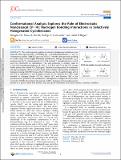Files in this item
Conformational analysis explores the role of electrostatic non-classical CFHC hydrogen bonding interactions in selectively halogenated cyclohexanes
Item metadata
| dc.contributor.author | He, Menfang | |
| dc.contributor.author | Piscelli, Bruno | |
| dc.contributor.author | Cormanich , Rodrigo | |
| dc.contributor.author | O'Hagan, David | |
| dc.date.accessioned | 2024-03-06T16:30:08Z | |
| dc.date.available | 2024-03-06T16:30:08Z | |
| dc.date.issued | 2024-03-05 | |
| dc.identifier | 299451252 | |
| dc.identifier | d6d9a3b3-c80e-47af-b6d7-7e87c9bfd7e7 | |
| dc.identifier | 85187010400 | |
| dc.identifier.citation | He , M , Piscelli , B , Cormanich , R & O'Hagan , D 2024 , ' Conformational analysis explores the role of electrostatic non-classical CFHC hydrogen bonding interactions in selectively halogenated cyclohexanes ' , The Journal of Organic Chemistry , vol. 89 , no. 6 , pp. 4009–4018 . https://doi.org/10.1021/acs.joc.3c02868 | en |
| dc.identifier.issn | 0022-3263 | |
| dc.identifier.other | ORCID: /0000-0002-0510-5552/work/155069028 | |
| dc.identifier.uri | https://hdl.handle.net/10023/29451 | |
| dc.description | Funding: Fundação de Amparo à Pesquisa do Estado de São Paulo - 2018/03910-1, 2023/14064-2; China Scholarship Council; Fundo de Apoio ao Ensino, à Pesquisa e Extensão, Universidade Estadual de Campinas - 3472/23 | en |
| dc.description.abstract | The conformational equilibria of selectively halogenated cyclohexanes are explored both experimentally (VT-NMR) for 1,1,4,-trifluorocyclohexane 7 and by computational analysis (M06-2X/aug-cc-pVTZ level), with the latter approach extending to a wider range of more highly fluorinated cyclohexanes. Perhaps unexpectedly, 7ax is preferred over the 7eq conformation by ΔG = 1.06 kcal mol–1, contradicting the accepted norm for substituents on cyclohexanes. The axial preference is stronger again in 1,1,3,3,4,5,5,-heptafluorocyclohexane 9 (ΔG = 2.73 kcal mol–1) as the CF2 groups further polarize the isolated CH2 hydrogens. Theoretical decomposition of electrostatic and hyperconjugative effects by natural bond orbital analysis indicated that nonclassical hydrogen bonding (NCHB) between the C-4 fluorine and the diaxial hydrogens at C-2 and C-6 in cyclohexane 7 and 9 largely accounts for the observed bias. The study extended to changing fluorine (F) for chlorine (Cl) and bromine (Br) at the pseudoanomeric position in the cyclohexanes. Although these halogens do not become involved in NCHBs, they polarize the geminal −CHX– hydrogen at the pseudoanomeric position to a greater extent than fluorine, and consequent electrostatic interactions influence conformer stabilities. | |
| dc.format.extent | 10 | |
| dc.format.extent | 2817847 | |
| dc.language.iso | eng | |
| dc.relation.ispartof | The Journal of Organic Chemistry | en |
| dc.subject | QD Chemistry | en |
| dc.subject | NDAS | en |
| dc.subject.lcc | QD | en |
| dc.title | Conformational analysis explores the role of electrostatic non-classical CFHC hydrogen bonding interactions in selectively halogenated cyclohexanes | en |
| dc.type | Journal article | en |
| dc.contributor.institution | University of St Andrews. Institute of Behavioural and Neural Sciences | en |
| dc.contributor.institution | University of St Andrews. EaSTCHEM | en |
| dc.contributor.institution | University of St Andrews. Biomedical Sciences Research Complex | en |
| dc.contributor.institution | University of St Andrews. School of Chemistry | en |
| dc.identifier.doi | https://doi.org/10.1021/acs.joc.3c02868 | |
| dc.description.status | Peer reviewed | en |
This item appears in the following Collection(s)
Items in the St Andrews Research Repository are protected by copyright, with all rights reserved, unless otherwise indicated.

